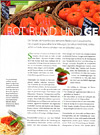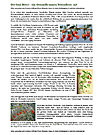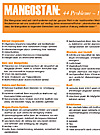Goji-Saft und seine Bedeutung
 Goji-Beeren sind gespeicherte, konzentrierte Lichtenergie und ein natürliches Energetikum für Körper, Geist und Seele.
Goji-Beeren sind gespeicherte, konzentrierte Lichtenergie und ein natürliches Energetikum für Körper, Geist und Seele.
In der Hamalaya-Region sind die Vorteile der Goji Beere für die Gesundheit schon seit Jahrtausenden bekannt. Auch in der chinesischen Tradition wird die Goji-Beere vielfältig eingesetzt, z.B. um niedrige Energie zu beheben.
In Tibet ist die Goji-Beere bekannt dafür, dass sie:
- das Augenlicht unterstützt
- Leber und Nieren nährt
- Anti-Aging-Wirkungen hat
- das Immunsystem unterstützt
- freien Radikalen vorbeugt
- gesundes Cholesterin unterstützt
- positive unterstützende Wirkungen auf Blutdruck, Zuckerspiegel, Gehirn und Blutgefäße hat
Traditionell nehmen die Chinesen und Bewohner des Himalayas und Tibets getrocknete Goji-Beeren gegen hohen Blutdruck und Blutzucker, bei Augenproblemen, zur Unterstützung des Immunsystems und zur Vorbeugung und Behandlung von Krebs.
Goji-Saft versorgt Ihren Körper mit wertvollen pflanzlichen Substanzen mit einem hohen antioxidativen Potential. Er ist hilfreich bei der Vitalisierung, Anregung und der Regeneration Ihres Körpers. Die Erkenntnisse der Kräuter-Experten aus China, Tibet und Indien wurden von Generation zu Generation bis in die heutige Zeit übermittelt. Goji-Saft kann die Abwehrkräfte stärken, den Organismus im Gleichgewicht halten und Energieblockaden lösen.
Die moderne Wissenschaft hat sich für die Inhaltsstoffe interessiert und in Laborstudien erste Hinweise auf medizinische Wirksamkeit gefunden:
- Polysaccharide aus der Pflanze haben immunmodulierende Wirkung (http://de.wikipedia.org/wiki/Goji)
- Es gibt mehrere Laborstudien und eine klinische Studie zur Wirksamkeit gegen Krebs (http://de.wikipedia.org/wiki/Goji)
- Wässrige Extrakte aus gemeinem Bocksdorn haben starke antioxidative Eigenschaften (http://de.wikipedia.org/wiki/Goji)
Die Goji-Beere - ein Gesundbrunnen besonderer Art
©Red. gesundheit.com/Cornelius Hoffmann/Fotos: Wikipedia, Noea Ltd, Institut für Mangostan & natürliche Antioxidantien
Es ist schon eine bemerkenswerte Geschichte: Binnen weniger Jahre forschen weltweit tausende von Wissenschaftlern intensiv an einer kleinen, korallen-roten Frucht. Der Grund: ihr absolut beispielloser Reichtum an gesundheits-fördernden Inhaltsstoffen. Über 2.700 wissenschaftliche Forschungsstudien und med. Erfahrungsberichte wurden über die verblüffende Wirkung der ansonsten allgemein unbekannten Goji-Beere, die den lateinischen Namen Lycium barbarum trägt, veröffentlicht.
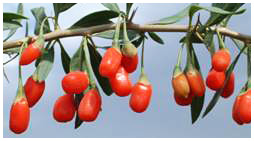 So enthält die Goji-Beere beispielsweise 4.000 Prozent mehr Antioxidantien als Orangen und mehr B-Vitamine als jede andere Frucht. Dazu entdeckten Wissenschaftler ein bislang unvergleichliches Potential an Mineralien und Spurenelementen sowie vielen weiteren Vitaminen und anderen bekannten und bisher unbekannten Vitalstoffen. In Fachkreisen spricht man bereits von einer wahren Gesundheits- und Anti-Aging-Sensation.
So enthält die Goji-Beere beispielsweise 4.000 Prozent mehr Antioxidantien als Orangen und mehr B-Vitamine als jede andere Frucht. Dazu entdeckten Wissenschaftler ein bislang unvergleichliches Potential an Mineralien und Spurenelementen sowie vielen weiteren Vitaminen und anderen bekannten und bisher unbekannten Vitalstoffen. In Fachkreisen spricht man bereits von einer wahren Gesundheits- und Anti-Aging-Sensation.
Auch der bekannte amerikanische Experte für Ernährung und Nahrungsergänzungsmittel, Prof. Dr. Dr. Earl Mindell, Verfasser von mehreren Dutzend Gesundheits-Bestsellern, bestätigte nach eingehender Analyse:"Die Goji-Beere enthält das mit Abstand größte Potential an gesundheitsfördernden Vitalstoffen das mir in meiner jahrzehnte langen Forschung begegnete. Ihre positive Wirkung auf den Organismus ist unvergleichlich und wird von keiner anderen bisher bekannten Pflanze erreicht."
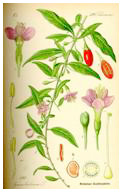 In Zentralasien galt die Goji-Frucht von alters her wegen ihrer hervorragenden Wirkung in Bezug auf Gesundheit, Langlebigkeit, Vitalität und Schönheit als allererste Wahl. Dass dies nicht ohne Grund ist, belegen neuste wissenschaftliche Untersuchungsergebnisse und Analysen aus aller Welt. Es ist die einzigartige Fülle und Zusammensetzung von bislang z. T. unbekannten Vitalstoffen, durch welche diese Frucht bei so vielen Beschwerden, Symptomen und Krankheitsbildern hervorragende Ergebnisse zeigt, ohne die geringste Spur von unerwünschten Nebenwirkungen.
In Zentralasien galt die Goji-Frucht von alters her wegen ihrer hervorragenden Wirkung in Bezug auf Gesundheit, Langlebigkeit, Vitalität und Schönheit als allererste Wahl. Dass dies nicht ohne Grund ist, belegen neuste wissenschaftliche Untersuchungsergebnisse und Analysen aus aller Welt. Es ist die einzigartige Fülle und Zusammensetzung von bislang z. T. unbekannten Vitalstoffen, durch welche diese Frucht bei so vielen Beschwerden, Symptomen und Krankheitsbildern hervorragende Ergebnisse zeigt, ohne die geringste Spur von unerwünschten Nebenwirkungen.
Dabei sind die getrockneten Goji-Früchtchen ebenso kostengünstig wie wohlschmeckend. Eine handvoll täglich verzehrt, soll innerhalb weniger Wochen wahre Wunder bewirken, was ich inzwischen selbst bestätigen kann. Aufmerksam wurden die Medien erst, als die Hollywood-Prominenz diese Beeren als das Nonplusultra für Wohlbefinden, Gesundheit und Anti-Aging entdeckte und sich diese Kunde nahezu explosionsartig innerhalb weniger Monate in den USA, in Kanada, Australien und Neuseeland verbreitete. Die Nachfrage überstieg bisweilen das Angebot, der meist aus Zentralchina stammenden Früchte, obwohl alleine in der freien Provinz Ningxia 2007 über 850.000 Zentner Goji-Beeren von rund 45 Mio. Goji-Sträuchern geerntet wurden.
Nun schwappt die Goji-Welle nach Europa. Großbritannien und Irland hat die Neuigkeit bereits erreicht, vor allem im Biohandel avancierten Goji-Produkte binnen weniger Wochen zum Umsatzträger Nummer eins unter den Gesundheitsprodukten.
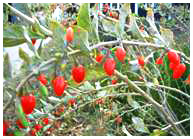 Doch hier die beste Nachricht: Goji-Sträucher wachsen in nahezu allen Regionen dieser Welt - auch in Europa. So kann praktisch jeder im heimischen Garten diesen Strauch selbst ziehen und damit die Frucht mit der größten Dichte und Vielfalt an Vitalstoffen unter allen bislang bekannten Nahrungsmitteln selbst ernten. Versierte Baumschulen verzeichnen bereits eine sprunghaft ansteigende Nachfrage nach Lycium-barbarum Sträuchern.
Doch hier die beste Nachricht: Goji-Sträucher wachsen in nahezu allen Regionen dieser Welt - auch in Europa. So kann praktisch jeder im heimischen Garten diesen Strauch selbst ziehen und damit die Frucht mit der größten Dichte und Vielfalt an Vitalstoffen unter allen bislang bekannten Nahrungsmitteln selbst ernten. Versierte Baumschulen verzeichnen bereits eine sprunghaft ansteigende Nachfrage nach Lycium-barbarum Sträuchern.
Wolfberry ist eine häufig in den USA anzutreffende Bezeichnung der Goji-Beere. Lycium barbarum ist die wissenschaftlich-lateinische Bezeichnung der Goji-Pflanze. International setzt sich immer mehr der Begriff Goji-Beere oder Goji-Berry (engl.) durch.
© Red. gesundheit.com/Cornelius Hoffmann/Fotos:
Wikipedia, Noea Ltd, Institut für Mangostan & natürliche Antioxidantien
GOJI-BEERE
(Lycium barbarum / Wolfsbeere / Wolfberry)
Aktuelle wissenschaftliche Studien | 1-14
Quelle: Datenbank der U.S. National Library of Medicine and the National Institutes of Health (siehe http://www.ncbi.nlm.nih.gov/sites/entrez)
1: J Pharm Biomed Anal. 2008 Aug 5;47(4-5):812-8. Epub 2008 Apr 8.
Related Articles, Links
![]()
Determination of carotenoids and their esters in fruits of Lycium barbarum Linnaeus by HPLC-DAD-APCI-MS.
Inbaraj BS, Lu H, Hung CF, Wu WB, Lin CL, Chen BH.
Department of Food Science, Fu Jen University, Taipei 242, Taiwan.
The fruit of Lycium barbarum Linnaeus, a traditional Chinese herb containing functional components such as carotenoids, flavonoids and polysaccharides, has been widely used in the health food industry because of its possible role in the prevention of chronic disease like age-related macular degeneration. The objectives of this study were to develop a high performance liquid chromatography-photo diode array detection-mass spectrometry (HPLC-DAD-MS) method with atmospheric pressure chemical ionization (APCI) mode for qualitative and quantitative analyses of carotenoids in fruits of L. barbarum. Dried samples of L. barbarum were subjected to extraction without saponification or extraction followed by saponification. A C30 column with a gradient mobile phase of methylene chloride (100%) and methanol-acetonitrile-water (81:14:5, v/v/v) was used to separate carotenoids, with a total of 11 free carotenoids and 7 carotenoid esters being resolved from unsaponified and saponified L. barbarum extracts within 51 and 41min, respectively. The fatty acid composition of carotenoid esters was confirmed by gas chromatography. Zeaxanthin dipalmitate (1143.7mug/g) was present in the largest amount, followed by beta-cryptoxanthin monopalmitate and its two isomers (32.9-68.5mug/g), zeaxanthin monopalmitate and its two isomers (11.3-62.8mug/g), all-trans-beta-carotene (23.7mug/g) and all-trans-zeaxanthin (1.4mug/g).
PMID: 18486400 [PubMed - in process]
2: Phytochemistry. 2008 Jun;69(9):1850-8. Epub 2008 May 9.
Related Articles,
Links
![]()
Ascorbic acid conjugates isolated from the phloem of Cucurbitaceae.
Hancock RD, Chudek JA, Walker PG, Pont SD, Viola R.
Scottish Crop Research Institute, Plant Products and Food Quality, Invergowrie, Dundee DD2 5DA, United Kingdom.
Analysis of phloem exudates from the fruit of Cucurbitaceae revealed the presence of several compounds with UV-visible absorption spectra identical to that of l-ascorbic acid. In Cucurbita pepo L. (zucchini), the compounds could be isolated from phloem exudates collected from aerial parts of the plant but were not detected in whole tissue homogenates. The compounds isolated from the phloem exudates of C. pepo fruit were eluted from strong anion exchange resin in the same fraction as l-ascorbic acid and were oxidised by ascorbate oxidase (E.C. 1.10.3.3). The major compound purified from C. pepo fruit exudates demonstrated similar redox properties to l-ascorbic acid and synthetic 6-O-glucosyl-l-ascorbic acid (6-GlcAsA) but differed from those of 2-O-glucosyl-l-ascorbic acid (2-GlcAsA) isolated from the fruit of Lycium barbarum L. Parent and fragment ion masses of the compound were consistent with hexosyl-ascorbate in which the hexose moiety was attached to C5 or C6 of AsA. Acid hydrolysis of the major C. pepo compound resulted in the formation of l-ascorbic acid and glucose. The purified compound yielded a proton NMR spectrum that was almost identical to that of synthetic 6-GlcAsA. A series of l-ascorbic acid conjugates have, therefore, been identified in the phloem of Cucurbitaceae and the most abundant conjugate has been identified as 6-GlcAsA. The potential role of such conjugates in the long-distance transport of l-ascorbic acid is discussed.
PMID: 18472116 [PubMed - in process]
3: J Altern Complement Med. 2008 May;14(4):403-12.
Related Articles,
Links
![]()
A randomized, double-blind, placebo-controlled, clinical study of the general effects of a standardized Lycium barbarum (Goji) Juice, GoChi.
Amagase H, Nance DM.
FreeLife International, LLC, Phoenix, AZ 85040, USA. hamagase@freelife.com
BACKGROUND: This randomized, double-blind, placebo-controlled clinical trial is the first study reported from outside China that has examined the general effects of the orally consumed goji berry, Lycium barbarum, as a standardized juice (GoChi; FreeLife International LLC, Phoenix, AZ) to healthy adults for 14 days. METHODS: Based upon the medicinal properties of Lycium barbarum in traditional Asian medicine, we examined by questionnaire subjective ratings (0-5) of general feelings of well-being, neurologic/psychologic traits, gastrointestinal, musculoskeletal, and cardiovascular complaints as well as any adverse effects. Also, measures of body weight, body-mass index, blood pressure, pulse rate, and visual acuity were assessed before and after consuming 120 mL of GoChi/day or placebo control solution. Data were statistically analyzed for changes between day 1 and day 15. RESULTS: Significant differences between day 1 and day 15 were found in the GoChi group (N = 16) in increased ratings for energy level, athletic performance, quality of sleep, ease of awakening, ability to focus on activities, mental acuity, calmness, and feelings of health, contentment, and happiness. GoChi also significantly reduced fatigue and stress, and improved regularity of gastrointestinal function. In contrast, the placebo group (N = 18) showed only two significant changes (heartburn and happiness). No significant changes in musculoskeletal or cardiovascular complaints were observed in either group. All parametric data (body weight, etc.) were not significantly different between groups or between day 1 and day 15 for either group. CONCLUSIONS: These results clearly indicate that daily consumption of GoChi for 14 days increases subjective feelings of general well-being, and improves neurologic/psychologic performance and gastrointestinal functions. The data strongly suggest that further research is indicated to confirm and extend knowledge of the potential effects of Lycium barbarum upon human health.
Publication Types:
PMID: 18447631 [PubMed - in process]
4: Int J Biol Macromol. 2008 Jun 1;42(5):447-9. Epub 2008 Feb 29.
Related Articles,
Links
![]()
Protective effect of Lycium barbarum polysaccharides on oxidative damage in skeletal muscle of exhaustive exercise rats.
Niu AJ, Wu JM, Yu DH, Wang R.
Wushu Department, Guangzhou sport university, Guangzhou 510500, China. niuniuwoaini@sohu.com
The aim of this study was to determine the modulatory effect of Lycium barbarum polysaccharides (LBP) on the oxidative stress induced by an exhaustive exercise. 32 male Wistar rats were taken in the study. The experiment was a 30-day exhaustive exercise program. We determined the lipid peroxidation, glycogen levels, and anti-oxidant enzyme activities in skeletal muscle. The results demonstrated that L. barbarum polysaccharides administration significantly increases glycogen level and anti-oxidant enzyme activities, and decreased malondialdehyde (MDA) level and creatine kinase activities. In conclusion, L. barbarum polysaccharides administration can significantly decrease the oxidative stress induced by the exhaustive exercise.
PMID: 18405964 [PubMed - in process]
5: Gynecol Endocrinol. 2008 Mar;24(3):161-70.
Related Articles,
Links
![]()
Pharmacological investigations of the unique herbal formula Menoprogen in rats: estrogenic activity and mechanism.
Lu Y, Ma H, Liu D.
Chinese Academy of Science, Jiangsu Institute of Botany, Nanjing, People's Republic of China.
The present study aimed to evaluate the pharmacological effects of Menoprogen in the management of menopausal symptoms for aged female rats. Menoprogen was supplemented to a group of elderly female rats for 8 weeks. Subsequently, histopathological examinations were conducted in the isolated uterine and ovary tissues and pituitary glands of the rats. Serum levels of estradiol (E(2)), progesterone (P), follicle-stimulating hormone (FSH) and luteinizing hormone (LH) were determined. The ultrastructure of the rat ovarian granulocytes was analyzed. The histopathological examinations revealed no statistical difference in the quantity of follicles in the ovary and of acidophil and basophil cells in the anterior pituitary gland of the Menoprogen-fed rats versus healthy normal rats. Moreover, the cellular morphogenesis was in a healthy state for the Menoprogen-fed rats. Menoprogen significantly increased the levels of serum E(2) and P but reduced FSH and LH levels. The electron microscopic analysis showed that Menoprogen significantly retarded apoptosis of the ovarian granulocytes of the rats. Further investigation of Menoprogen for the alternative treatment of menopausal symptoms is warranted.
Publication Types:
PMID: 18335332 [PubMed - indexed for MEDLINE]
6: Evolution. 2008 May;62(5):1052-65. Epub 2008 Mar 1.
Related Articles,
Links
A tale of two continents: Baker's rule and the maintenance of self-incompatibility in Lycium (Solanaceae).
Miller JS, Levin RA, Feliciano NM.
Department of Biology, Amherst College, Amherst, MA 01002, USA. jsmiller@amherst.edu
Over 50 years ago, Baker (1955, 1967) suggested that self-compatible species were more likely than self-incompatible species to establish new populations on oceanic islands. His logic was straightforward and rested on the assumption that colonization was infrequent; thus, mate limitation favored the establishment of self-fertilizing individuals. In support of Baker's rule, many authors have documented high frequencies of self-compatibility on islands, and recent work has solidified the generality of Baker's ideas. The genus Lycium (Solanaceae) has ca. 80 species distributed worldwide, and phylogenetic studies suggest that Lycium originated in South America and dispersed to the Old World a single time. Previous analyses of the S-RNase gene, which controls the stylar component of self-incompatibility, have shown that gametophytically controlled self-incompatibility is ancestral within the genus, making Lycium a good model for investigating Baker's assertions concerning reproductive assurance following oceanic dispersal. Lycium is also useful for investigations of reproductive evolution, given that species vary both in sexual expression and the presence of self-incompatibility. A model for the evolution of gender dimorphism suggests that polyploidy breaks down self-incompatibility, leading to the evolution of gender dimorphism, which arises as an alternative outcrossing mechanism. There is a perfect association of dimorphic gender expression, polyploidy, and self-compatibility (vs. cosexuality, diploidy, and self-incompatibility) among North American Lycium. Although the association between ploidy level and gender expression also holds for African Lycium, to date no studies of mating systems have been initiated in Old World species. Here, using controlled pollinations, we document strong self-incompatibility in two cosexual, diploid species of African Lycium. Further, we sequence the S-RNase gene in 15 individuals from five cosexual, diploid species of African Lycium and recover 24 putative alleles. Genealogical analyses indicate reduced trans-generic diversity of S-RNases in the Old World compared to the New World. We suggest that genetic diversity at this locus was reduced as a result of a founder event, but, despite the bottleneck, self-incompatibility was maintained in the Old World. Maximum-likelihood analyses of codon substitution patterns indicate that positive Darwinian selection has been relatively strong in the Old World, suggesting the rediversification of S-RNases following a bottleneck. The present data thus provide a dramatic exception to Baker's rule, in addition to supporting a key assumption of the Miller and Venable (2000) model, namely that self-incompatibility is associated with diploidy and cosexuality.
Publication Types:
PMID: 18315577 [PubMed - indexed for MEDLINE]
7: Wei Sheng Yan Jiu. 2007 Nov;36(6):743-5.
Related Articles,
Links
[Effects of Lycium barbarum on the behavior, body weight and TNF-alpha level of rat treated with binding]
[Article in Chinese]
Li H, Liu X, Yang H, Zhu L.
Department of Environmental Health, Ningxia Medical College, Yinchuan 750004, China. lihh31@sina.com
OBJECTIVE: To explore the effects of Lycium barbarum (L) on the behavior and body weight and TNF-alpha level of rat treated with binding. METHODS: Rats were randomly divided into 6 groups: control group,binding group, 2.5% L group, 5.0% L group, 2.5% L plus binding group, 5.0% L plus binding group. Lycium barbarums were pressed into juice, then rats were fed with the dranking water contening juice. Rats were bound to restrict for 21 days. RESULTS: (1) The increases of serum-cortisol level and the decreases of body weight and the increases of TNF-alpha level of rats of binding group in comparision with control groups (P < 0.05) (2) Rats body weight gain, movement and TNF-alpha level in both of 2.5% L plus binding group and 5.0% L plus binding group were more higher than those in binding group (P < 0.05). Serum-cortisol level of these two groups were more lower and had statistical significance in comparison with those of binding groups (P < 0.05). CONCLUSION: Binding could suppress body weight gain and markedly reduce the activity and TNF-alpha level of rat. Lycium barbarum could be a good adjustment on the behavior, body weight and TNF-alpha.
Publication Types:
PMID: 18303642 [PubMed - in process]
8: Food Chem Toxicol. 2008 May;46(5):1860-2. Epub 2008 Jan 15.
Related Articles,
Links
![]()
Warfarin overdose due to the possible effects of Lycium barbarum L.
Leung H, Hung A, Hui AC, Chan TY.
Department of Medicine and Therapeutics, The Chinese University of Hong Kong, Prince of Wales Hospital, Shatin, NT, Hong Kong. howanleung@hotmail.com
We reported an 80-year-old Chinese woman on chronic stable dose of warfarin who experienced two episodes of an elevated international normalized ratio (INR) after drinking herbal tea containing Lycium barbarum L. Our case illustrated the potential herbal-drug interaction between warfarin and L. barbarum L. in keeping with a previous case report. Enquiry about herbal intake may be a crucial part in the management of anticoagulation in this locality.
Publication Types:
PMID: 18281140 [PubMed - indexed for MEDLINE]
9: J Agric Food Chem. 2008 Feb 13;56(3):627-9. Epub 2008 Jan 23.
Related Articles,
Links
![]()
Berry fruits: compositional elements, biochemical activities, and the impact of their intake on human health, performance, and disease.
Seeram NP.
Center for Human Nutrition, David Geffen School of Medicine, University of California, Los Angeles, California 90095, USA. nseeram@mail.uri.edu
An overwhelming body of research has now firmly established that the dietary intake of berry fruits has a positive and profound impact on human health, performance, and disease. Berry fruits, which are commercially cultivated and commonly consumed in fresh and processed forms in North America, include blackberry ( Rubus spp.), black raspberry ( Rubus occidentalis), blueberry ( Vaccinium corymbosum), cranberry (i.e., the American cranberry, Vaccinium macrocarpon, distinct from the European cranberry, V. oxycoccus), red raspberry ( Rubus idaeus) and strawberry ( Fragaria x ananassa). Other berry fruits, which are lesser known but consumed in the traditional diets of North American tribal communities, include chokecherry ( Prunus virginiana), highbush cranberry ( Viburnum trilobum), serviceberry ( Amelanchier alnifolia), and silver buffaloberry ( Shepherdia argentea). In addition, berry fruits such as arctic bramble ( Rubus articus), bilberries ( Vaccinuim myrtillus; also known as bog whortleberries), black currant ( Ribes nigrum), boysenberries ( Rubus spp.), cloudberries ( Rubus chamaemorus), crowberries ( Empetrum nigrum, E. hermaphroditum), elderberries ( Sambucus spp.), gooseberry ( Ribes uva-crispa), lingonberries ( Vaccinium vitis-idaea), loganberry ( Rubus loganobaccus), marionberries ( Rubus spp.), Rowan berries ( Sorbus spp.), and sea buckthorn ( Hippophae rhamnoides), are also popularly consumed in other parts of the world. Recently, there has also been a surge in the consumption of exotic "berry-type" fruits such as the pomegranate ( Punica granatum), goji berries ( Lycium barbarum; also known as wolfberry), mangosteen ( Garcinia mangostana), the Brazilian açaí berry ( Euterpe oleraceae), and the Chilean maqui berry ( Aristotelia chilensis). Given the wide consumption of berry fruits and their potential impact on human health and disease, conferences and symposia that target the latest scientific research (and, of equal importance, the dissemination of this information to the general public), on the chemistry and biological and physiological functions of these "superfoods" are necessary.
Publication Types:
PMID: 18211023 [PubMed - indexed for MEDLINE]
10: J Phys Chem B. 2008 Feb 14;112(6):1806-19. Epub 2008 Jan 19.
Related Articles,
Links
![]()
Pulsed EPR and DFT characterization of radicals produced by photo-oxidation of zeaxanthin and violaxanthin on silica-alumina.
Focsan AL, Bowman MK, Konovalova TA, Molnár P, Deli J, Dixon DA, Kispert LD.
Department of Chemistry, University of Alabama, Tuscaloosa, AL 35487-0336, USA.
Pulsed electron nuclear double resonance (ENDOR) and two-dimensional (2D)-hyperfine sublevel correlation spectroscopy (HYSCORE) studies in combination with density functional theory (DFT) calculations revealed that photo-oxidation of natural zeaxanthin (ex Lycium halimifolium) and violaxanthin (ex Viola tricolor) on silica-alumina produces the carotenoid radical cations (Car*+) and also the neutral carotenoid radicals (#Car*) as a result of proton loss (indicated by #) from the C4(4') methylene position or one of the methyl groups at position C5(5'), C9(9'), or C13(13'), except for violaxanthin where the epoxide at positions C5(5')-C6(6') raises the energy barrier for proton loss, and the neutral radicals #Car*(4) and #Car*(5) are not observed. DFT calculations predict the largest isotropic beta-methyl proton hyperfine couplings to be 8 to 10 MHz for Car*+, in agreement with previously reported hyperfine couplings for carotenoid pi-conjugated radicals with unpaired spin density delocalized over the whole molecule. Anisotropic alpha-proton hyperfine coupling tensors determined from the HYSCORE analysis were assigned on the basis of DFT calculations with the B3LYP exchange-correlation functional and found to arise not only from the carotenoid radical cation but also from carotenoid neutral radicals, in agreement with the analysis of the pulsed ENDOR data. The formation of the neutral radical of zeaxanthin should provide another effective nonphotochemical quencher of the excited state of chlorophyll for photoprotection in the presence of excess light.
Publication Types:
PMID: 18205344 [PubMed - indexed for MEDLINE]
11: Sichuan Da Xue Xue Bao Yi Xue Ban. 2007 Nov;38(6):1040-2.
Related Articles,
Links
[Simultaneous determination of monosaccharides and oligosaccharides in Lycium barbarum L. by high performance liquid chromatography]
[Article in Chinese]
Ouyang HX, Li YQ, Xiao QW.
Department of Sanitary Technology, West China School of Public Health, Sichuan University, Chengdu, China.
OBJECTIVE: To develop a rapid approach of refractive index detection with high performance liquid chromatography (HPLC) for the determination of rhamnose, fructose, glucose, surose and maltose in Lycium barbarum L. METHODS: The sample was extracted with water and the analyte was separated by Zorbax Carbohydrate column with acetonitrile-water as mobile phase. RESULTS: Good linear correlations between the concentrations and the peak areas of the analyte were found, with the correlation coefficients ranging from 0.9976 to 0.9998. The spiked recovery rates ranged from 92.27% to 101.93%, with 1.85%-3.27% of relative standard deviations (n=5). The limits of detection (S/N =3) were 4-6 mg/kg. CONCLUSION: The proposed method is suitable for the determination of monosaccharide and oligosaccharide in Lycium barbarum L.
Publication Types:
PMID: 18095617 [PubMed - in process]
12: J Nurs Res. 2007 Dec;15(4):310-8.
Related Articles,
Links
An investigation into competence in TCM of BSN graduates from technological universities in Taiwan.
Yeh YC, Chung UL.
Military Office, Hungkuang University.
The purpose of this study was to determine what competences in Traditional Chinese Medicine (TCM) should be possessed by Bachelor of Science in Nursing (BSN) graduates from technological universities in Taiwan. There were two phases in this study: focus groups and expert panel discussion. First, we held four focus groups, and interviewed 31 participants, including consumers, nursing staff and clinical nursing faculty. The interview tapes were transcribed verbatim, were proofed for accuracy and the content was analyzed. The results were then discussed by four academic experts in a panel discussion. Results indicated that the TCM competences of BSN graduates from technological universities should include the following: (1) to understand the basic concepts of TCM, including Yin/Yang, the Five Evolutive Phases, holistic view, the Five Viscera and Six Bowels, Meridians, etiology, and concepts of therapy and health preservation; (2) to recognize the cold and hot nature of food; (3) to illustrate the common dietetic care for immune enhancement in the four seasons, and the foods that help postnatal and postoperative physical regeneration; (4) to illustrate the properties, indications, and administration of common Chinese medicines, including: Ginseng, Lycium, Astragalus, Angelica sinensis (danggui), Chrysanthemum, Pinellia, Zizyphi fructus; (5) to describe the properties, indications, adverse effects, and administration of Siwutang and Shenghuatang; (6) to describe basic principles of administering both Chinese medicine and Western medicine; (7) to describe the indications and cautions of the following techniques: acupuncture, scraping therapy, and cupping; (8) to implement acupressure as a measure for promoting comfort under the following conditions: pain, vomiting, insomnia, palpitations; and (9) to demonstrate an open mind and cautious attitude to respect consumers using TCM. Results of the study can serve as a reference for nurse educators when training BSN graduates from technological universities in TCM competences.
PMID: 18080975 [PubMed - indexed for MEDLINE]
13: Biotechnol Appl Biochem. 2007 Dec 5. [Epub ahead of print]
Related Articles,
Links
![]()
Application of sequence characterized amplified region (SCAR) analysis to authenticate Lycium barbarum and its adulterants.
Sze SC, Song JX, Wong RN, Feng YB, Ng TB, Tong Y, Zhang KY.
Fructus Lycii (Gouqizi) is well-known in Chinese herbal medicine for its restorative function of benefiting the liver and the kidney, replenishing vital essence and improving eyesight. However, ten species and varieties of Lycium are found to be substitutes or adulterants of L. barbarum in the commercial market in Hong Kong and China. L. barbarum cv. 'Tianjinense' and L. chinense var. potaninii are the most common examples. It is difficult to differentiate among the Lycium species by traditional morphological and histological analysis. An easy and reliable approach based on SCAR (Sequence Characterized Amplified Region) analysis was developed in this study to differentiate L. barbarum from other Lycium species. Two characteristic bands of about 700 and 650 bp were detected on the RAPD (Random Amplified Polymorphic DNA) profiles generated from samples of L. barbarum and L. chinense var. potaninii using primer OPC-7. They were isolated and sequenced. Two primer sets, based on the sequences, could amplify a single specific band in samples of L. barbarum respectively while no bands were detected in samples of L. chinense var. potaninii. The results confirmed that the SCAR technique can be employed for authenticating L. barbarum and its adulterants.
PMID: 18052933 [PubMed - as supplied by publisher]
14: Zhong Yao Cai. 2007 Jun;30(6):672-7.
Related Articles,
Links
[Experimental study of anti-atherosclerosis potency by lycium seed oil and its possible mechanism]
[Article in Chinese]
Jiang YD, Cao J, Dong QZ, Wang SR.
Department of Pathophysiology, Sichuan University, Chengdu 610041, China. jwcjyd@163.com
OBJECTIVE: To study the effect of anti-atherosclerosis of Lycium Seed Oil (Lso) and its possible mechanism. METHODS: The rabbit atherosclerosis model was established by high fat diet, and the TC, TG, LDL-C, HDL-C levels in plasma were examined dynamically. The SOD, GSH-PX, T-AOC activities and the MDA levels in serum were monitored after 8 week's high fat diet. Aorta samples were observed for atherosclerotic extent, and NF-kappaB, TNF-alpha were assessed by immuno-histochemical method. The lovastatin was set up as a positive control. RESULTS: contents of HDL-C obviously increased in Plasma of low and high dosage groups and TC, TG, LDL-C levels significantly decreased compared with control group. The SOD, GSH-PX, T-AOC activities up-regulated while the NF-kappaB, MDA and NF-alpha levels decreased in Lycium Seed Oil groups compared with control group. Aortic atherosclerotic extent and area in low dosage and high dosage LSO groups were absolutely smaller than that in high fat diet group. The anti-atherosclerosis potency of Lycium Seed Oil was similar with that of lovastatin. CONCLUSION: Lycium Seed Oil has potent anti-atherosclerosis effects and its anti-atherosclerosis potency was similar with The lovastatin. The possible mechanism involve the decreasing of plasma lipids, anti-peroxidation, inhibiting the activation of NF-kappaB and down-regulating the inflammation cytokines of TNF-alpha.
Publication Types:
PMID: 17918438 [PubMed - indexed for MEDLINE]
96-115 | 116-135 | 136-155 | 156-175 | 176-187









